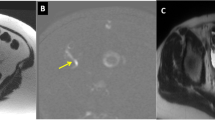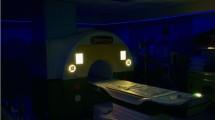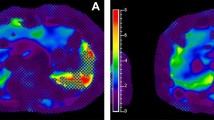Abstract
While there are many challenges specific to pediatric abdomino-pelvic MRI, many recent advances are addressing these challenges. It is therefore essential for radiologists to be familiar with the latest advances in MR imaging. Laudable efforts have also recently been implemented in many centers to improve the overall experience of pediatric patients, including the use of dedicated radiology child life specialists, MRI video goggles, and improved MR suite environments. These efforts have allowed a larger number of children to be scanned while awake, with fewer studies being done under sedation or anesthesia; this has resulted in additional challenges from patient motion and difficulties with breath-holding and tolerating longer scan times. In this review, we highlight common challenges faced in imaging the pediatric abdomen and pelvis and discuss the application of the newest techniques to address these challenges. Additionally, we highlight the newest advances in quantified imaging techniques, specifically in MR liver iron quantification. The techniques described in this review are all commercially available and can be readily implemented.















Similar content being viewed by others
References
Parker MW, Shah SS, Hall M et al (2015) Computed tomography and shifts to alternate imaging modalities in hospitalized children. Pediatrics 136:e573–e581
Jung D, Denna J, John W et al (2016) Cardiac magnetic resonance imaging can be performed without the use of anesthesia in patients 7–10 years of age with child life support and MRI video goggles. J Cardiovasc Magn Reson 18:O120
Durand DJ, Mollie Y, Paul N et al (2015) Mandatory child life consultation and its impact on pediatric MRI workflow in an academic medical center. J Am Coll Radiol 12:594–598
Harned RK 2nd, Strain JD (2001) MRI-compatible audio/visual system: impact on pediatric sedation. Pediatr Radiol 31:247–250
Courtier J, Cardenas A, Tan C et al (2015) Non-anesthesia MR enterography in very young children — feasibility, technique and performance. J Pediatr Gastroenterol Nutr. doi:10.1097/MPG.0000000000000712
Greene DJ, Black KJ, Schlaggar BL (2016) Considerations for MRI study design and implementation in pediatric and clinical populations. Dev Cogn Neurosci 18:101–112
Poldrack RA, Paré-Blagoev EJ, Grant PE (2002) Pediatric functional magnetic resonance imaging: progress and challenges. Top Magn Reson Imaging 13:61–70
Kotsoni E, Eleni K, Dana B et al (2006) Special considerations for functional magnetic resonance imaging of pediatric populations. J Magn Reson Imaging 23:877–886
Drevets WC, Videen TQ, MacLeod AK et al (1992) PET images of blood flow changes during anxiety: correction. Science 256:1696
Chavhan GB, Babyn PS, Vasanawala SS (2013) Abdominal MR imaging in children: motion compensation, sequence optimization, and protocol organization. Radiographics 33:703–719
Vasanawala SS, Iwadate Y, Church DG et al (2010) Navigated abdominal T1-W MRI permits free-breathing image acquisition with less motion artifact. Pediatr Radiol 40:340–344
Chandarana H, Hersh C, Block KT et al (2013) Free-breathing contrast-enhanced T1-weighted gradient-echo imaging with radial k-space sampling for paediatric abdominopelvic MRI. Eur Radiol 24:320–326
Shin HJ, Kim M-J, Lee M-J et al (2016) Comparison of image quality between conventional VIBE and radial VIBE in free-breathing paediatric abdominal MRI. Clin Radiol 71:1044–1049
Fujinaga Y, Yasunari F, Ayumi O et al (2014) Radial volumetric imaging breath-hold examination (VIBE) with k-space weighted image contrast (KWIC) for dynamic gadoxetic acid (Gd-EOB-DTPA)-enhanced MRI of the liver: advantages over Cartesian VIBE in the arterial phase. Eur Radiol 24:1290–1299
Kierans A, Parikh N, Chandarana H (2015) Recent advances in MR hardware and software. Radiol Clin N Am 53:599–610
Fujinaga Y, Yasunari F, Yoshihiro K et al (2015) Advantages of radial volumetric breath-hold examination (VIBE) with k-space weighted image contrast reconstruction (KWIC) over Cartesian VIBE in liver imaging of volunteers simulating inadequate or no breath-holding ability. Eur Radiol 26:2790–2797
Roque A, Andreia R, Miguel R et al (2014) Post-contrast T1-weighted sequences in pediatric abdominal imaging: comparative analysis of three different sequences and imaging approach. Pediatr Radiol 44:1258–1265
Li XH, Jiang Z, Zhang XM et al (2013) Abdominal MRI at 3.0 T: LAVA-Flex compared with conventional fat suppression T1-weighted images. J Magn Reson Imaging 40:58–66
Taylor AM, Jhooti P, Wiesmann F et al (1997) MR navigator-echo monitoring of temporal changes in diaphragm position: implications for MR coronary angiography. J Magn Reson Imaging 7:629–636
Augui J, Vignaux O, Argaud C et al (2002) Liver: T2-weighted MR imaging with breath-hold fast-recovery optimized fast spin-echo compared with breath-hold half-Fourier and non-breath-hold respiratory-triggered fast spin-echo pulse sequences. Radiology 223:853–859
Reinig JW (1995) Breath-hold fast spin-echo MR imaging of the liver: a technique for high-quality T2-weighted images. Radiology 194:303–304
Adeb M, Darge K, Dillman JR et al (2013) Magnetic resonance urography in evaluation of duplicated renal collecting systems. Magn Reson Imaging Clin N Am 21:717–730
Pipe JG (1999) Motion correction with PROPELLER MRI: application to head motion and free-breathing cardiac imaging. Magn Reson Med 42:963–969
Lane BF, Vandermeer FQ, Oz RC et al (2011) Comparison of sagittal T2-weighted BLADE and fast spin-echo MRI of the female pelvis for motion artifact and lesion detection. AJR Am J Roentgenol 197:W307–W313
Rosenkrantz AB, Mannelli L, Mossa D et al (2011) Breath-hold T2-weighted MRI of the liver at 3 T using the BLADE technique: impact upon image quality and lesion detection. Clin Radiol 66:426–433
Haneder S, Dinter D, Gutfleisch A et al (2011) Image quality of T2W-TSE of the abdomen and pelvis with Cartesian or BLADE-type k-space sampling: a retrospective interindividual comparison study. Eur J Radiol 79:177–182
Maki JH, Wilson GJ, Eubank WB et al (2007) Steady-state free precession MRA of the renal arteries: breath-hold and navigator-gated techniques vs CE-MRA. J Magn Reson Imaging 26:966–973
Silverman JM, Friedman ML, Van Allan RJ (1996) Detection of main renal artery stenosis using phase-contrast cine MR angiography. AJR Am J Roentgenol 166:1131–1137
Miyazaki M, Mitsue M, Lee VS (2008) Nonenhanced MR angiography 1. Radiology 248:20–43
Glockner JF, Naoki T, Akira K et al (2010) Non-contrast renal artery MRA using an inflow inversion recovery steady state free precession technique (Inhance): comparison with 3D contrast-enhanced MRA. J Magn Reson Imaging 31:1411–1418
Xu J-L, Shi D-P, Li Y-L et al (2011) Non-enhanced MR angiography of renal artery using inflow-sensitive inversion recovery pulse sequence: a prospective comparison with enhanced CT angiography. Eur J Radiol 80:e57–e63
Chavhan GB, Zehour A, Babyn PS (2014) Diffusion-weighted imaging in pediatric body MR imaging: principles, technique, and emerging applications. Radiographics 34:E73–E88
Fehniger J, Thomas S, Lengyel E et al (2016) A prospective study evaluating diffusion weighted magnetic resonance imaging (DW-MRI) in the detection of peritoneal carcinomatosis in suspected gynecologic malignancies. Gynecol Oncol 142:169–175
Ream JM, Dillman JR, Jeremy A et al (2013) MRI diffusion-weighted imaging (DWI) in pediatric small bowel Crohn disease: correlation with MRI findings of active bowel wall inflammation. Pediatr Radiol 43:1077–1085
Neubauer H, Henning N, Thomas P et al (2012) Small-bowel MRI in children and young adults with Crohn disease: retrospective head-to-head comparison of contrast-enhanced and diffusion-weighted MRI. Pediatr Radiol 43:103–114
Shenoy-Bhangle AS, Katherine N, Thomas A et al (2015) Value of diffusion-weighted imaging when added to magnetic resonance enterographic evaluation of Crohn disease in children. Pediatr Radiol 46:34–42
Parikh T, Drew SJ, Lee VS et al (2008) Focal liver lesion detection and characterization with diffusion-weighted MR imaging: comparison with standard breath-hold T2-weighted imaging. Radiology 246:812–822
Koh D-M, Collins DJ, Orton MR (2011) Intravoxel incoherent motion in body diffusion-weighted MRI: reality and challenges. AJR Am J Roentgenol 196:1351–1361
Kachewar SG (2011) Using DWIBS MRI technique as an alternative to bone scan or PET scan for whole-body imaging in oncology patients. Acta Radiol 52:788
Li Z, Pipe JG, Lee C-Y et al (2011) X-PROP: a fast and robust diffusion-weighted PROPELLER technique. Magn Reson Med 66:341–347
Deng J, Miller FH, Salem R et al (2006) Multishot diffusion-weighted PROPELLER magnetic resonance imaging of the abdomen. Investig Radiol 41:769–775
Mürtz P, Petra M, Carsten K et al (2007) Diffusion-weighted whole-body MR imaging with background body signal suppression: a feasibility study at 3.0 tesla. Eur Radiol 17:3031–3037
Anupindi SA, Podberesky DJ, Towbin AJ et al (2015) Pediatric inflammatory bowel disease: imaging issues with targeted solutions. Abdom Imaging 40:975–992
Bhatti L, Hoang JK, Dale BM et al (2015) Advanced magnetic resonance techniques: 3 T. Radiol Clin N Am 53:441–455
Breuer FA, Blaimer M, Mueller MF et al (2006) Controlled aliasing in volumetric parallel imaging (2D CAIPIRINHA). Magn Reson Med 55:549–556
Yutzy SR, Seiberlich N, Duerk JL et al (2011) Improvements in multislice parallel imaging using radial CAIPIRINHA. Magn Reson Med 65:1630–1637
Morani AC, Vicens RA, Wei W et al (2015) CAIPIRINHA-VIBE and GRAPPA-VIBE for liver MRI at 1.5 T. J Comput Assist Tomogr 39:263–269
Saranathan M, Manojkumar S, Rettmann DW et al (2012) Differential subsampling with Cartesian ordering (DISCO): a high spatio-temporal resolution Dixon imaging sequence for multiphasic contrast enhanced abdominal imaging. J Magn Reson Imaging 35:1484–1492
Egbert ND, Bloom DA, Dillman JR (2013) Magnetic resonance imaging of the pediatric pancreaticobiliary system. Magn Reson Imaging Clin N Am 21:681–696
Arizono S, Shigeki A, Hiroyoshi I et al (2010) High spatial resolution 3D MR cholangiography with high sampling efficiency technique (SPACE): comparison of 3 T vs. 1.5 T. Eur J Radiol 73:114–118
Haystead CM, Dale BM, Merkle EM (2008) N/2 ghosting artifacts: elimination at 3.0-T MR cholangiography with SPACE pulse sequence. Radiology 246:589–595
Dickerson EC, Dillman JR, Smith EA et al (2015) Pediatric MR urography: indications, techniques, and approach to review. Radiographics 35:1208–1230
Hernando D, Diego H, Levin YS et al (2014) Quantification of liver iron with MRI: state of the art and remaining challenges. J Magn Reson Imaging 40:1003–1021
Gandon Y, Olivié D, Guyader D et al (2004) Non-invasive assessment of hepatic iron stores by MRI. Lancet 363:357–362
Kim D, Jensen JH, Wu EX et al (2009) Breathhold multiecho fast spin-echo pulse sequence for accurate R2 measurement in the heart and liver. Magn Reson Med 62:300–306
St Pierre TG, Clark PR, Chua-anusorn W et al (2005) Noninvasive measurement and imaging of liver iron concentrations using proton magnetic resonance. Blood 105:855–861
Tran VT, Vasanawala S (2013) Pediatric hepatobiliary magnetic resonance imaging. Radiol Clin N Am 51:599–614
Wood JC (2005) MRI R2 and R2* mapping accurately estimates hepatic iron concentration in transfusion-dependent thalassemia and sickle cell disease patients. Blood 106:1460–1465
Robson MD, Gatehouse PD, Bydder M et al (2003) Magnetic resonance: an introduction to ultrashort TE (UTE) imaging. J Comput Assist Tomogr 27:825–846
Author information
Authors and Affiliations
Corresponding author
Ethics declarations
Conflicts of interest
None
Rights and permissions
About this article
Cite this article
Courtier, J., Rao, A.G. & Anupindi, S.A. Advanced imaging techniques in pediatric body MRI. Pediatr Radiol 47, 522–533 (2017). https://doi.org/10.1007/s00247-017-3778-0
Received:
Revised:
Accepted:
Published:
Issue Date:
DOI: https://doi.org/10.1007/s00247-017-3778-0




